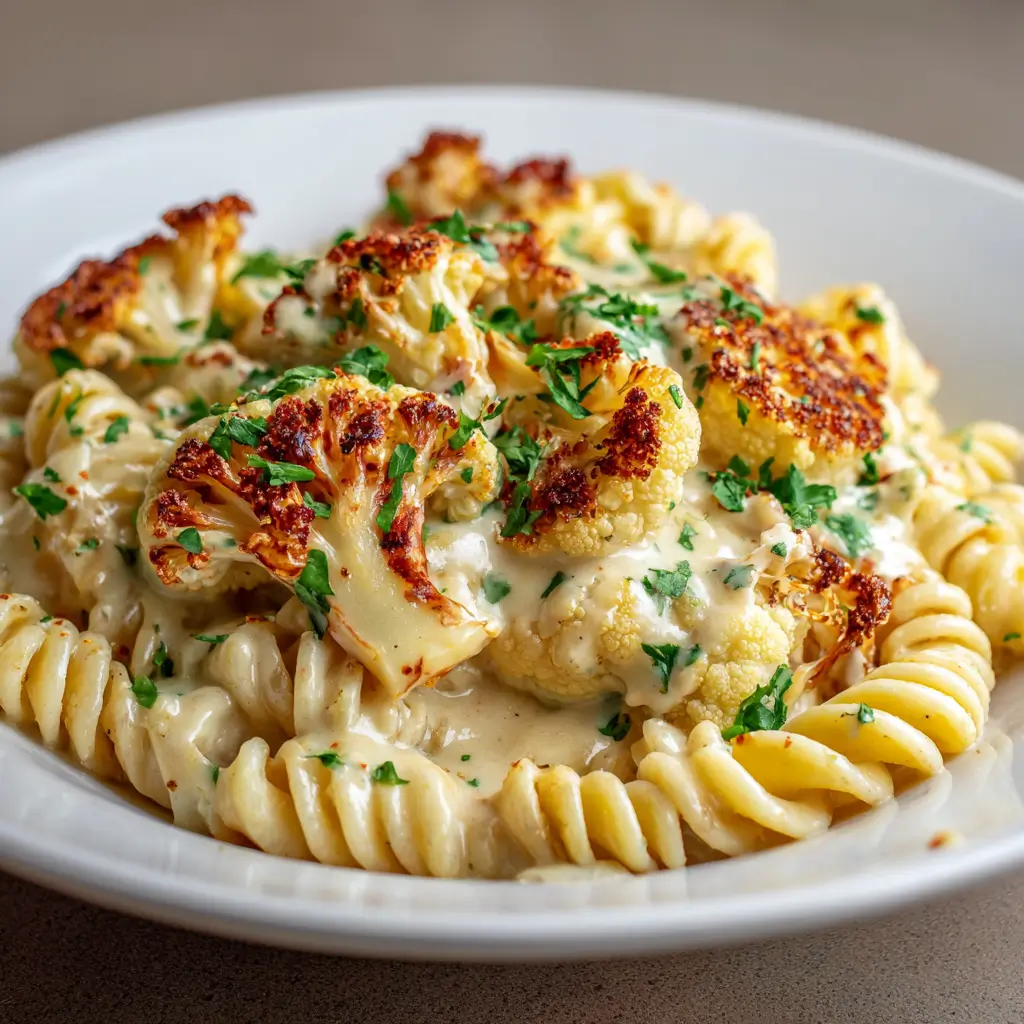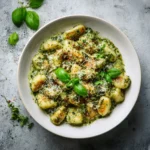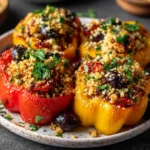Vegan Cauliflower Alfredo Pasta: A Creamy, Healthy, and Delicious Plant-Based Delight
The History of Vegan Cauliflower Alfredo Pasta
The classic Italian Alfredo sauce, traditionally made with heavy cream, butter, and Parmesan cheese, has long been a favorite comfort food around the world. However, as plant-based diets have surged in popularity due to health, environmental, and ethical concerns, chefs and home cooks alike began seeking dairy-free alternatives that capture the luxurious texture and rich flavor of traditional Alfredo without compromising on taste. Enter the vegan cauliflower Alfredo—a modern culinary innovation rooted in necessity but elevated by creativity.
Cauliflower, a cruciferous vegetable known for its mild flavor and creamy texture when blended, emerged as a star ingredient in the 2010s during the rise of clean eating and whole-food plant-based lifestyles. Its ability to mimic dairy-based sauces made it an ideal candidate for vegan versions of mac and cheese, soups, and—most notably—Alfredo sauce. The first iterations of this dish likely originated in health-focused blogs and vegan cookbooks, where resourceful cooks discovered that steamed cauliflower, when combined with nutritional yeast, garlic, and plant-based fats, could produce a velvety sauce remarkably similar to its dairy-laden counterpart.
Over time, this recipe evolved beyond niche dietary circles and gained mainstream appeal. It’s now featured in plant-based restaurants, meal prep guides, and even celebrity chef cookbooks. What began as a compromise for those avoiding dairy has become a beloved dish in its own right—celebrated not just for what it omits, but for what it offers: a wholesome, nutrient-dense, and satisfying alternative that doesn’t skimp on indulgence.
Ingredients Breakdown
The magic of vegan cauliflower Alfredo lies in its simplicity and the synergy between a few key ingredients. Each component plays a vital role in building flavor, texture, and nutrition:
- Fresh Cauliflower: The base of the sauce, providing creaminess and body. When steamed and blended, cauliflower becomes silky smooth and neutral in taste, making it the perfect canvas for other flavors.
- Unsweetened Plant-Based Milk: Typically unsweetened almond, oat, or cashew milk is used to thin the sauce and enhance creaminess without adding sweetness or overpowering flavors.
- Nutritional Yeast: This deactivated yeast gives the sauce its signature cheesy, umami-rich flavor. Packed with B vitamins and protein, it’s a staple in vegan cooking.
- Garlic: Fresh garlic adds depth and a subtle pungency that enhances the overall savoriness of the sauce.
- Lemon Juice: A splash brightens the sauce, cutting through the richness and balancing the flavors.
- Olive Oil or Refined Coconut Oil: Adds richness and mouthfeel, mimicking the fat content of traditional butter. Olive oil contributes a fruity note, while refined coconut oil keeps the flavor neutral.
- Onion Powder and Salt: Enhance overall flavor complexity and help season the sauce evenly.
- White Pepper (optional): Offers a gentle heat and sophisticated finish without the visual specks of black pepper.
- Pasta of Choice: Fettuccine is traditional, but penne, linguine, or gluten-free pasta work well too.
- Optional Add-ins: Sautéed mushrooms, spinach, sun-dried tomatoes, roasted red peppers, or peas can elevate the dish with extra texture and nutrients.
Step-by-Step Recipe
Follow these detailed steps to create a luscious, restaurant-quality vegan cauliflower Alfredo pasta at home:
- Prepare the Cauliflower: Remove the leaves and stem from one medium head of cauliflower. Cut into small, even florets (about 4–5 cups). Rinse thoroughly under cold water.
- Steam the Cauliflower: Place the florets in a steamer basket over boiling water. Cover and steam for 12–15 minutes, or until very tender when pierced with a fork. Do not skip this step—properly cooked cauliflower blends smoothly and ensures a creamy texture.
- Cook the Pasta: While the cauliflower steams, bring a large pot of salted water to a boil. Add 12 oz (340g) of your preferred pasta and cook according to package instructions until al dente. Reserve ½ cup of pasta water before draining.
- Blend the Sauce: Transfer the steamed cauliflower to a high-speed blender. Add ¾ cup unsweetened plant-based milk, ⅓ cup nutritional yeast, 3 cloves minced garlic, 2 tablespoons olive oil, 2 tablespoons lemon juice, 1 teaspoon onion powder, ½ teaspoon salt, and a pinch of white pepper. Blend on high for 1–2 minutes, scraping down the sides as needed, until completely smooth and creamy. If the sauce is too thick, add more plant milk, 1 tablespoon at a time.
- Combine Sauce and Pasta: In a large mixing bowl or directly in the drained pasta pot, pour the creamy cauliflower sauce over the cooked pasta. Toss gently to coat every strand. If the sauce is too thick, gradually stir in reserved pasta water, a few tablespoons at a time, until the desired consistency is reached.
- Adjust Seasoning: Taste and adjust with additional salt, lemon juice, or nutritional yeast as needed. For extra richness, stir in another tablespoon of olive oil or a spoonful of raw cashew butter.
- Serve Immediately: Divide into bowls and garnish with fresh parsley, cracked black pepper, red pepper flakes, or vegan Parmesan if desired.
Expert Tips for the Best Vegan Cauliflower Alfredo
- Use a High-Speed Blender: A regular blender may leave the sauce grainy. For the silkiest results, use a Vitamix, Blendtec, or similarly powerful blender.
- Don’t Overcook the Cauliflower: While it needs to be tender, over-steaming can introduce excess water, diluting the sauce. Steam just until fork-tender.
- Season in Layers: Season both the cauliflower water (lightly salted) and the final sauce. Layering flavors builds depth.
- Acidity is Key: Lemon juice lifts the richness. If you don’t have lemon, a splash of apple cider vinegar works too.
- Warm the Plant Milk: Cold milk can cause the sauce to seize or become lumpy. Warm it slightly before blending for a smoother emulsion.
- Reserve Pasta Water: The starchy liquid helps bind the sauce to the pasta and improves texture dramatically.
- Make Ahead Tip: The sauce can be refrigerated for up to 4 days or frozen for up to 3 months. Reheat gently on the stove with a splash of plant milk to restore creaminess.
Variations and Customizations
This versatile recipe welcomes endless creativity. Here are some delicious ways to customize your vegan cauliflower Alfredo:
- Protein-Packed Version: Stir in cooked lentils, chickpeas, crumbled tofu, tempeh bacon, or store-bought vegan chicken strips.
- Creamier Texture: Add ¼ cup soaked raw cashews or 2 tablespoons of tahini to the blender for extra richness.
- Roasted Garlic Twist: Replace raw garlic with 4–5 cloves of roasted garlic for a sweeter, mellow flavor.
- Herb-Infused: Blend in fresh basil, thyme, or oregano for a garden-fresh twist.
- Spicy Kick: Add a dash of cayenne, smoked paprika, or blend in a roasted jalapeño for heat.
- Dairy-Free “Parmesan” Topping: Sprinkle with homemade vegan Parmesan (blend ½ cup cashews, 3 tbsp nutritional yeast, ½ tsp garlic powder, and ¼ tsp salt).
- Gluten-Free Option: Use gluten-free pasta such as brown rice, chickpea, or lentil-based noodles.
- Low-Fat Version: Omit the olive oil and increase plant milk slightly. The sauce will be lighter but still flavorful.
- Colorful Veggie Boost: Fold in steamed broccoli, sautéed zucchini, cherry tomatoes, or artichoke hearts after tossing with pasta.
- Seafood Style: Add marinated and baked king oyster mushrooms to mimic scallops or shrimp.
Health Considerations and Nutritional Value
Vegan cauliflower Alfredo isn’t just delicious—it’s a nutritionally balanced meal that supports overall wellness. Here’s why this dish stands out:
- Low in Saturated Fat: Unlike traditional Alfredo, which relies on butter and heavy cream, this version uses heart-healthy fats from olive oil and no cholesterol.
- Rich in Fiber: Both cauliflower and whole-grain pasta (if used) contribute dietary fiber, promoting digestion and satiety.
- Vitamins and Antioxidants: Cauliflower is packed with vitamin C, vitamin K, folate, and antioxidants like glucosinolates, which support detoxification and immune function.
- B Vitamin Boost: Nutritional yeast is an excellent source of B12 (when fortified), B6, and niacin—essential for energy metabolism and nerve health, especially important for vegans.
- Lower Calorie Count: This dish typically ranges from 350–450 calories per serving, depending on ingredients, making it a satisfying yet waistline-friendly option.
- Anti-Inflammatory Benefits: Garlic, olive oil, and cruciferous vegetables all possess anti-inflammatory properties linked to reduced risk of chronic diseases.
- Diabetes-Friendly: With careful pasta choice (e.g., legume-based), this dish can be low-glycemic and suitable for blood sugar management.
- Allergen Notes: Naturally dairy-free and egg-free. Use nut-free milk (like oat or soy) and omit cashews to make it nut-free. Gluten-free pasta makes it safe for celiacs.
Nutrition Estimate (per serving, serves 4):
| Nutrient | Amount |
|---|---|
| Calories | ~400 kcal |
| Total Fat | 14g |
| Saturated Fat | 2g |
| Carbohydrates | 55g |
| Dietary Fiber | 8g |
| Sugars | 6g |
| Protein | 15g |
| Sodium | 450mg |
| Vitamin C | 85% DV |
| Vitamin K | 70% DV |
| Calcium | 10% DV |
| Iron | 18% DV |
Full Ingredient List
- 1 medium head cauliflower (about 4–5 cups florets)
- 12 oz (340g) dried pasta (fettuccine, linguine, or penne)
- ¾ cup unsweetened plain plant-based milk (almond, oat, or soy)
- ⅓ cup nutritional yeast
- 3 cloves garlic, minced
- 2 tablespoons extra virgin olive oil (or refined coconut oil)
- 2 tablespoons fresh lemon juice
- 1 teaspoon onion powder
- ½ teaspoon sea salt (or to taste)
- ¼ teaspoon white pepper (optional)
- Reserved pasta water, as needed
Detailed Directions
- Disassemble the cauliflower into bite-sized florets. Rinse and drain well.
- In a large pot, bring 2 inches of water to a boil. Place a steamer basket inside, add cauliflower, cover, and steam for 12–15 minutes until very soft.
- Meanwhile, fill another large pot with salted water and bring to a rolling boil. Cook pasta according to package directions until al dente. Before draining, scoop out ½ cup of starchy cooking water and set aside.
- Drain the pasta and return it to the pot or a large serving bowl.
- Add the steamed cauliflower to a high-speed blender. Pour in plant milk, nutritional yeast, garlic, olive oil, lemon juice, onion powder, salt, and white pepper.
- Blend on high speed for 1–2 minutes, stopping to scrape down the sides, until the sauce is completely smooth and creamy. Add more plant milk (1 tbsp at a time) if too thick.
- Pour the sauce over the cooked pasta. Toss well to combine. Gradually add reserved pasta water (2–4 tbsp) until the sauce coats the noodles luxuriously.
- Taste and adjust seasoning—add more salt, lemon, or nutritional yeast as desired.
- Serve immediately in warm bowls. Garnish with chopped parsley, cracked pepper, red pepper flakes, or vegan Parmesan.
- Store leftovers in an airtight container in the refrigerator for up to 4 days. Reheat on the stovetop with a splash of plant milk to refresh the texture.
Frequently Asked Questions (FAQ)
Can I make this without a blender?
While a high-speed blender yields the best texture, you can use a food processor. However, the sauce may be slightly grainier. For a chunkier, rustic sauce, mash the steamed cauliflower by hand and whisk with the other ingredients, though it won’t be as creamy.
Why is my sauce too thin?
Over-blending or using too much liquid can thin the sauce. Simmer it gently in a saucepan for 3–5 minutes to reduce and thicken. You can also add a tablespoon of tapioca starch or cornstarch slurry to help thicken.
Can I use frozen cauliflower?
Yes, but thaw and drain it well first. Frozen cauliflower contains more moisture, so you may need to reduce added liquids or pat it dry before blending.
Is nutritional yeast necessary?
It’s highly recommended for the cheesy flavor. Without it, the sauce will lack depth. You can try a small amount of white miso or capers for umami, but the taste will differ.
How do I reheat leftovers?
Reheat gently on the stovetop over medium-low heat, stirring frequently and adding a splash of plant milk or water to loosen the sauce. Avoid microwaving at high power, as it can separate the sauce.
Can I bake this as a casserole?
Absolutely! Mix the sauced pasta with sautéed veggies and vegan cheese shreds, transfer to a baking dish, top with breadcrumbs, and bake at 375°F (190°C) for 20–25 minutes until golden.
Is this kid-friendly?
Many children love this dish because it’s creamy and mild. Try blending it extra smooth and serving with fun-shaped pasta to win over picky eaters.
Can I freeze the sauce?
Yes, the sauce freezes well for up to 3 months. Thaw overnight in the fridge and reheat slowly on the stove with added liquid to restore creaminess.
Summary
Vegan Cauliflower Alfredo Pasta is a creamy, dreamy, and wholesome plant-based twist on a classic comfort dish, delivering rich flavor and silky texture without any dairy. Packed with nutrients and endlessly customizable, it’s a must-have recipe for anyone seeking a healthier, compassionate way to enjoy pasta night.










